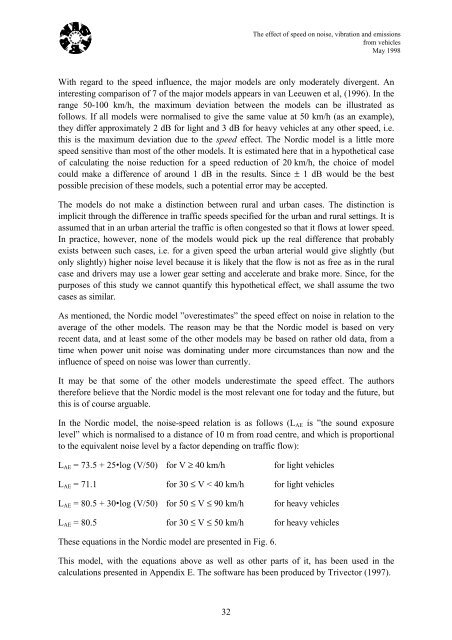appendix a - Velocidade
appendix a - Velocidade
appendix a - Velocidade
Create successful ePaper yourself
Turn your PDF publications into a flip-book with our unique Google optimized e-Paper software.
32<br />
The effect of speed on noise, vibration and emissions<br />
from vehicles<br />
May 1998<br />
With regard to the speed influence, the major models are only moderately divergent. An<br />
interesting comparison of 7 of the major models appears in van Leeuwen et al, (1996). In the<br />
range 50-100 km/h, the maximum deviation between the models can be illustrated as<br />
follows. If all models were normalised to give the same value at 50 km/h (as an example),<br />
they differ approximately 2 dB for light and 3 dB for heavy vehicles at any other speed, i.e.<br />
this is the maximum deviation due to the speed effect. The Nordic model is a little more<br />
speed sensitive than most of the other models. It is estimated here that in a hypothetical case<br />
of calculating the noise reduction for a speed reduction of 20 km/h, the choice of model<br />
could make a difference of around 1 dB in the results. Since ± 1 dB would be the best<br />
possible precision of these models, such a potential error may be accepted.<br />
The models do not make a distinction between rural and urban cases. The distinction is<br />
implicit through the difference in traffic speeds specified for the urban and rural settings. It is<br />
assumed that in an urban arterial the traffic is often congested so that it flows at lower speed.<br />
In practice, however, none of the models would pick up the real difference that probably<br />
exists between such cases, i.e. for a given speed the urban arterial would give slightly (but<br />
only slightly) higher noise level because it is likely that the flow is not as free as in the rural<br />
case and drivers may use a lower gear setting and accelerate and brake more. Since, for the<br />
purposes of this study we cannot quantify this hypothetical effect, we shall assume the two<br />
cases as similar.<br />
As mentioned, the Nordic model ”overestimates” the speed effect on noise in relation to the<br />
average of the other models. The reason may be that the Nordic model is based on very<br />
recent data, and at least some of the other models may be based on rather old data, from a<br />
time when power unit noise was dominating under more circumstances than now and the<br />
influence of speed on noise was lower than currently.<br />
It may be that some of the other models underestimate the speed effect. The authors<br />
therefore believe that the Nordic model is the most relevant one for today and the future, but<br />
this is of course arguable.<br />
In the Nordic model, the noise-speed relation is as follows (LAE is ”the sound exposure<br />
level” which is normalised to a distance of 10 m from road centre, and which is proportional<br />
to the equivalent noise level by a factor depending on traffic flow):<br />
LAE = 73.5 + 25. log (V/50) for V ≥ 40 km/h for light vehicles<br />
LAE = 71.1 for 30 ≤ V < 40 km/h for light vehicles<br />
LAE = 80.5 + 30. log (V/50) for 50 ≤ V ≤ 90 km/h for heavy vehicles<br />
LAE = 80.5 for 30 ≤ V ≤ 50 km/h for heavy vehicles<br />
These equations in the Nordic model are presented in Fig. 6.<br />
This model, with the equations above as well as other parts of it, has been used in the<br />
calculations presented in Appendix E. The software has been produced by Trivector (1997).


